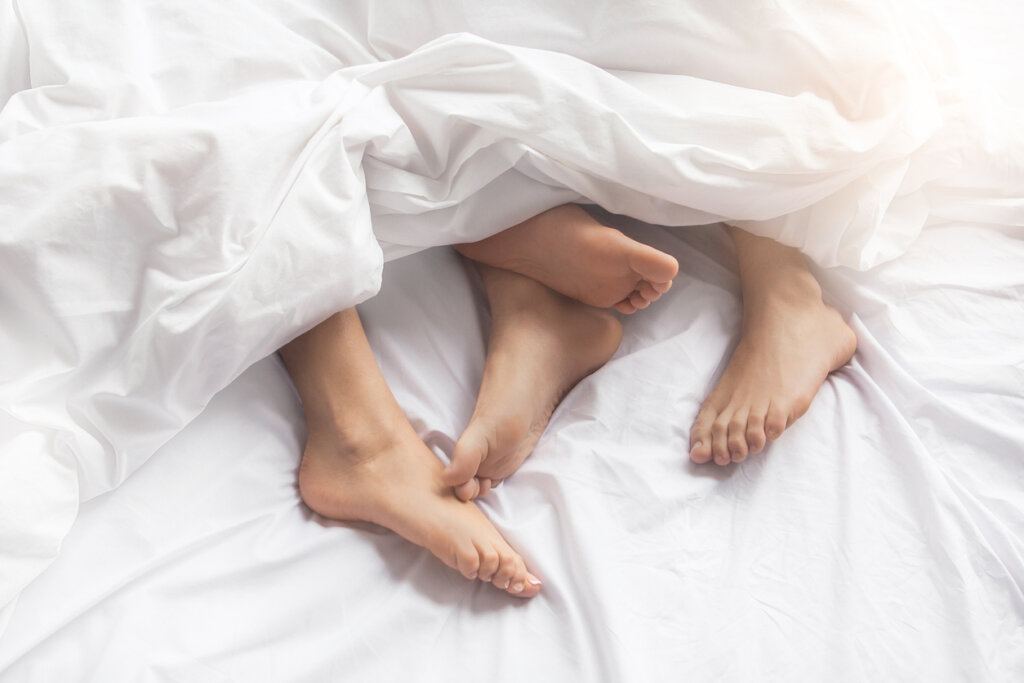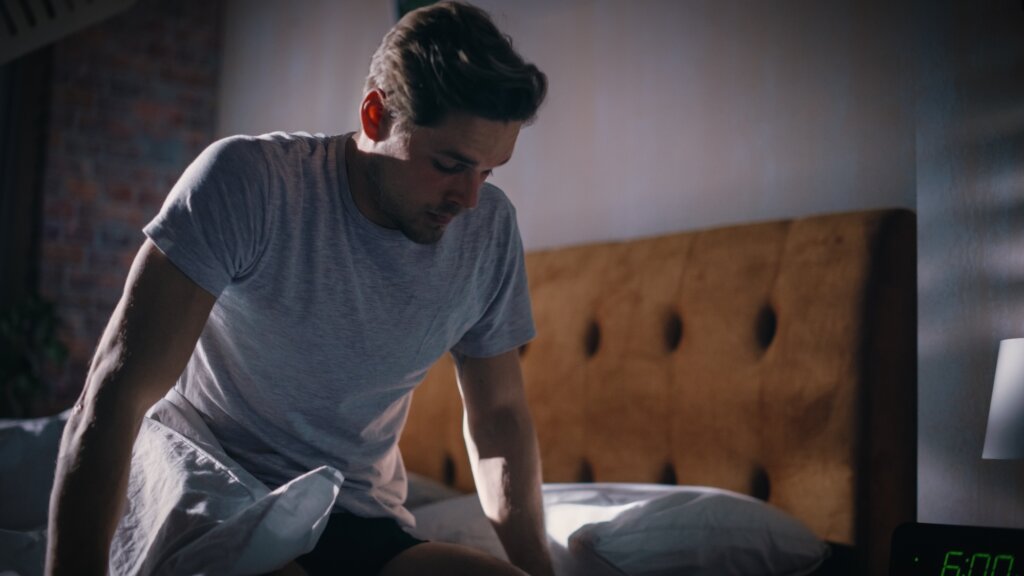Sexsomnia: Sleep Sex


Written and verified by the psychologist Elena Sanz
The human mind is fascinating and complex. Indeed, many of the alterations in normal cognitive and motor processes are surprising, to say the least. Such is the case of sexsomnia, also known as sleep sex. This is a disorder that’s often depicted in fictional movies and tv series. However, it’s a real condition that has significant repercussions for sufferers.
You may have heard of other phenomena that occur while you sleep, such as night terrors, sleepwalking, or sleep paralysis. Although different in their characteristics and manifestations, these are classified in the same diagnostic category as sexsomnia. But, the latter is less frequent. Moreover, not much is known about it, both on the part of the general population and clinicians.
In this article, we’re going to explain what sexsomnia consists of, why it occurs, and what can be done about it.
Sexsomnia or sleep sex
People suffering from this condition demonstrate inappropriate and unconscious sexual behaviors during the deep sleep stage. After falling asleep, they unconsciously adopt or try to adopt sexual behaviors. On waking, they don’t remember anything about it. This is how sexsomnia is defined by the International Classification of Sleep Disorders (ICSD).
Sexsomnia leads to masturbation or the attempt to have intercourse, either with a partner who sleeps in the same bed or another person who might be in another room. However, this behavior isn’t planned or intended. In fact, it’s qualitatively different from the way the sufferer usually acts when awake. For example, they might display ruder or even more violent attitudes.
At a clinical level, sexsomnia is included as one of the subtypes within parasomnias. These are abnormal behaviors associated with sleep. In the Diagnostic and Statistical Manual of Mental Disorders (DSM-V), this condition is reflected as sleep-related sexual behavior and is included within the condition of sleepwalking.
The symptoms of sexsomnia
The characteristics of this condition are highlighted in an article published in the journal, Neurología :
- Upon waking up and finding out what happened, the sufferer usually feels ashamed and regretful.
- They experience sexual arousal that’s accompanied by autonomic activation. For example, erections, vaginal lubrication, and even orgasms.
- The behavior is inappropriate and unusual. This means that it’s out of character for the sufferer and different from their usual way of acting.
- They’re unaware of their actions and experience complete amnesia concerning the episode. While it’s possible that they may wake up at some point during the experience, they usually remain asleep.
- The motor activation that takes place gives way to involuntary sexual behaviors. For example, rough masturbation, touching a partner, attempts to have intercourse or other sexual practices, or loud moans and vocalizations of sexual content.

Causes of sexsomnia
This disorder is rare. Consequently, there’s little medical information and clinical literature on the subject. This may be due, in part, to the modesty that sufferers feel when it comes to talking about their experiences and asking for professional help. In fact, in many cases, they’re unaware of what’s happening to them and their partner doesn’t talk about it either.
According to the Instituto del Sueño, Madrid (Spain) (Sleep Institute), this parasomnia affects approximately two percent of the world population. However, new research suggests that it could be even more common. As a matter of fact, a study published in Sleep Medicine suggests that sexsomnia represents about 19.4 percent of all NREM parasomnias.
Despite this, research in respect of the disorder is scarce and its causes haven’t been fully clarified. However, it’s believed that genetic and hereditary aspects play a role. And, according to the abovementioned research from the Instituto del Sueño, there are several risk factors and precipitants associated with sexsomnia. Among them are:
- Anxiety, stress, and fatigue.
- Sleep deprivation.
- Being a man. (It’s more prevalent in males than females).
- Alcohol use.
- Relationship problems.
- Other concomitant psychological disorders.
- Other comorbid parasomnias. For example, sleepwalking, apneas, or restless legs syndrome.
Treatment of sexsomnia
This parasomnia has serious negative repercussions on the sufferer and their relatives. Therefore, it’s important to seek professional help and start treatment.
As a rule, a diagnosis is made after analyzing the sufferer’s medical history. The professional will also corroborate the symptoms with relatives and friends and perform polysomnography.
They also might prescribe certain drugs such as clonazepam and other hypnotics to help reduce the frequency of episodes. This was confirmed in a review published in Sleep in 2007. However, it’s also essential for the sufferer to adjust their sleep hygiene, to prevent them from having fragmented or insufficient rest.
In addition, intervening in other concomitant conditions is also helpful. This fact was confirmed in a study published in Sleep Science in 2016.

Conclusions
Sexsomnia is rare, but it has a huge impact on sufferers’ lives. Indeed, it can cause feelings of confusion, shame, and guilt, lead to marital problems and anxiety in a relationship, and could even result in criminal and legal proceedings.
Therefore, it’s important not to ignore this condition and to always seek professional support. With appropriate intervention, it’s possible to minimize the onset of episodes or make them subside.
The human mind is fascinating and complex. Indeed, many of the alterations in normal cognitive and motor processes are surprising, to say the least. Such is the case of sexsomnia, also known as sleep sex. This is a disorder that’s often depicted in fictional movies and tv series. However, it’s a real condition that has significant repercussions for sufferers.
You may have heard of other phenomena that occur while you sleep, such as night terrors, sleepwalking, or sleep paralysis. Although different in their characteristics and manifestations, these are classified in the same diagnostic category as sexsomnia. But, the latter is less frequent. Moreover, not much is known about it, both on the part of the general population and clinicians.
In this article, we’re going to explain what sexsomnia consists of, why it occurs, and what can be done about it.
Sexsomnia or sleep sex
People suffering from this condition demonstrate inappropriate and unconscious sexual behaviors during the deep sleep stage. After falling asleep, they unconsciously adopt or try to adopt sexual behaviors. On waking, they don’t remember anything about it. This is how sexsomnia is defined by the International Classification of Sleep Disorders (ICSD).
Sexsomnia leads to masturbation or the attempt to have intercourse, either with a partner who sleeps in the same bed or another person who might be in another room. However, this behavior isn’t planned or intended. In fact, it’s qualitatively different from the way the sufferer usually acts when awake. For example, they might display ruder or even more violent attitudes.
At a clinical level, sexsomnia is included as one of the subtypes within parasomnias. These are abnormal behaviors associated with sleep. In the Diagnostic and Statistical Manual of Mental Disorders (DSM-V), this condition is reflected as sleep-related sexual behavior and is included within the condition of sleepwalking.
The symptoms of sexsomnia
The characteristics of this condition are highlighted in an article published in the journal, Neurología :
- Upon waking up and finding out what happened, the sufferer usually feels ashamed and regretful.
- They experience sexual arousal that’s accompanied by autonomic activation. For example, erections, vaginal lubrication, and even orgasms.
- The behavior is inappropriate and unusual. This means that it’s out of character for the sufferer and different from their usual way of acting.
- They’re unaware of their actions and experience complete amnesia concerning the episode. While it’s possible that they may wake up at some point during the experience, they usually remain asleep.
- The motor activation that takes place gives way to involuntary sexual behaviors. For example, rough masturbation, touching a partner, attempts to have intercourse or other sexual practices, or loud moans and vocalizations of sexual content.

Causes of sexsomnia
This disorder is rare. Consequently, there’s little medical information and clinical literature on the subject. This may be due, in part, to the modesty that sufferers feel when it comes to talking about their experiences and asking for professional help. In fact, in many cases, they’re unaware of what’s happening to them and their partner doesn’t talk about it either.
According to the Instituto del Sueño, Madrid (Spain) (Sleep Institute), this parasomnia affects approximately two percent of the world population. However, new research suggests that it could be even more common. As a matter of fact, a study published in Sleep Medicine suggests that sexsomnia represents about 19.4 percent of all NREM parasomnias.
Despite this, research in respect of the disorder is scarce and its causes haven’t been fully clarified. However, it’s believed that genetic and hereditary aspects play a role. And, according to the abovementioned research from the Instituto del Sueño, there are several risk factors and precipitants associated with sexsomnia. Among them are:
- Anxiety, stress, and fatigue.
- Sleep deprivation.
- Being a man. (It’s more prevalent in males than females).
- Alcohol use.
- Relationship problems.
- Other concomitant psychological disorders.
- Other comorbid parasomnias. For example, sleepwalking, apneas, or restless legs syndrome.
Treatment of sexsomnia
This parasomnia has serious negative repercussions on the sufferer and their relatives. Therefore, it’s important to seek professional help and start treatment.
As a rule, a diagnosis is made after analyzing the sufferer’s medical history. The professional will also corroborate the symptoms with relatives and friends and perform polysomnography.
They also might prescribe certain drugs such as clonazepam and other hypnotics to help reduce the frequency of episodes. This was confirmed in a review published in Sleep in 2007. However, it’s also essential for the sufferer to adjust their sleep hygiene, to prevent them from having fragmented or insufficient rest.
In addition, intervening in other concomitant conditions is also helpful. This fact was confirmed in a study published in Sleep Science in 2016.

Conclusions
Sexsomnia is rare, but it has a huge impact on sufferers’ lives. Indeed, it can cause feelings of confusion, shame, and guilt, lead to marital problems and anxiety in a relationship, and could even result in criminal and legal proceedings.
Therefore, it’s important not to ignore this condition and to always seek professional support. With appropriate intervention, it’s possible to minimize the onset of episodes or make them subside.
All cited sources were thoroughly reviewed by our team to ensure their quality, reliability, currency, and validity. The bibliography of this article was considered reliable and of academic or scientific accuracy.
- American Academy of Sleep Medicine. (2014). International classification of sleep disorders—third edition (ICSD-3). https://dokumen.pub/international-classification-of-sleep-disorders-third-edition-icsd-3-3nbsped-0991543416-0991543408.html
- American Psychological Association [APA]. (2014). Manual diagnóstico y estadístico de los trastornos mentales (DSM-5). https://www.academia.edu/50002540/DSM_V_Manual_Diagn%C3%B3stico_y_Estad%C3%ADstico_de_Trastornos_Mentales_5ta_Edicion
- Ariño, H., Iranzo, A., Gaig, C., & Santamaría, J. (2014). Sexsomnia. Una forma de parasomnia con conductas sexuales durante el sueño. Neurología, 29(3), 146-152. https://www.elsevier.es/es-revista-neurologia-295-articulo-sexsomnia-una-forma-parasomnia-con-S0213485313000194
- Instituto del Sueño (IIS). (2020). Sexsomnia. ¿En qué consiste el sonambulismo sexual? https://www.iis.es/sexsomnia-en-que-consiste-el-sonambulismo-sexual/
- Meira e Cruz, M., & Soca, R. (2016). Sexsomnia and REM-predominant obstructive sleep apnea effectively treated with a mandibular advancement device. Sleep Science, 9(3), 140-141. https://www.sciencedirect.com/science/article/pii/S1984006316300864
- Riha, R. L., Dodds, S., Kotoulas, S. C., & Morrison, I. (2023). A case-control study of sexualised behaviour in sleep: A strong association with psychiatric comorbidity and relationship difficulties. Sleep Medicine, 103, 33-40. https://www.sciencedirect.com/science/article/pii/S1389945723000230
- Schenck, C. H., Arnulf, I., & Mahowald, M. W. (2007). Sleep and sex: what can go wrong? A review of the literature on sleep related disorders and abnormal sexual behaviors and experiences. Sleep, 30(6), 683-702. https://pubmed.ncbi.nlm.nih.gov/17580590/
This text is provided for informational purposes only and does not replace consultation with a professional. If in doubt, consult your specialist.







